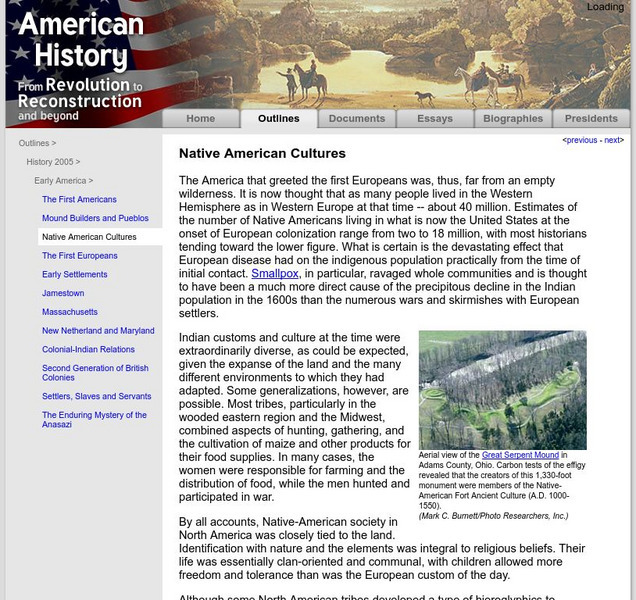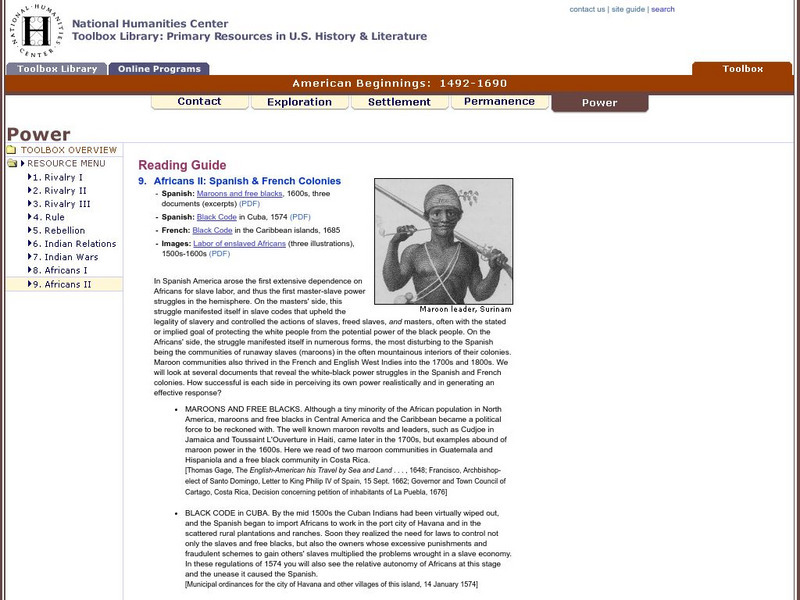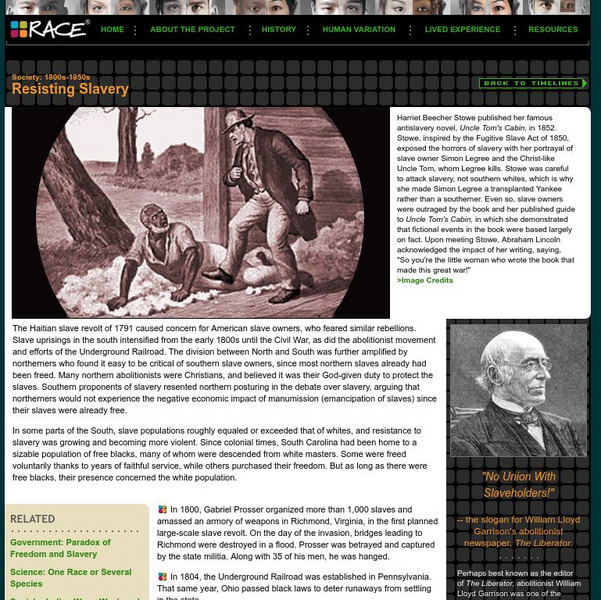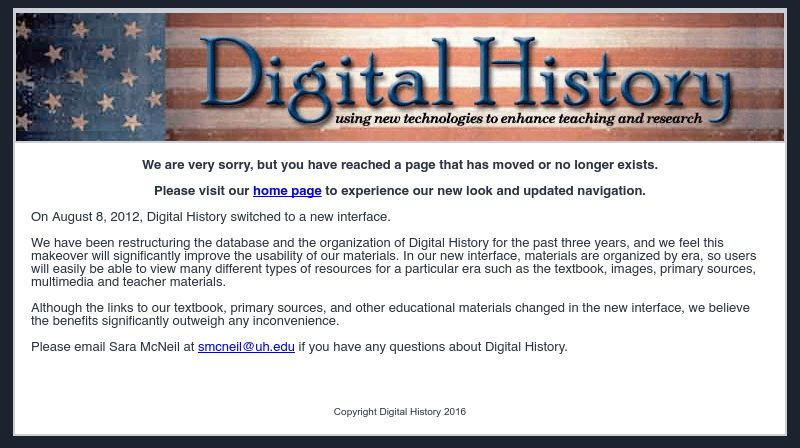Hi, what do you want to do?
Curated OER
Etc: European Colonization in North America, 1500 1700
A map of North America showing the European colonization in the region up to the year 1700. The map is color-coded to show the possessions of the British, French, Spanish, Dutch, Swedish, and Danish. The map shows the territory in...
Khan Academy
Khan Academy: Us History: 1491 1607: Environmental/health Effects in New World
European arrival in the Americas decimated both indigenous people and previously-flourishing ecosystems.
University of Groningen
American History: Outlines: Native American Cultures
The America that greeted the first Europeans was, thus, far from an empty wilderness. It is now thought that as many people lived in the Western Hemisphere as in Western Europe at that time -- about 40 million. Estimates of the number of...
Annenberg Foundation
Annenberg Learner: Colonial Settlement: Interactive Timeline
In this interactive timeline see how other European nations, along with the British, colonized America and how events in Europe impacted colonization.
National Humanities Center
National Humanities Center: Toolbox Library: Indian Relations, American Beginnings: 1492 1690
One modern historical assessment and several original accounts of the mistrust, negotiations, alliances, trading, and disease transmission between European colonizers and native peoples in North America.
National Humanities Center
National Humanities Center: Toolbox Library: Africans Ii, American Beginnings: 1492 1690
Three illustrations and five documents about slave codes, master-slave power dynamics, and free blacks within French and Spanish settlements of the Caribbean.
Library of Congress
Loc: American Memory Timeline: Colonial Settlement,1600s 1763
Read about the colonization in the New World by many European countries. Hyperlinks to you to more specific topics.
National Humanities Center
National Humanities Center: Toolbox Library: Enslaved Peoples, American Beginnings: 1492 1690
Two Spanish accounts of enslaved Indians in the Caribbean and enslaved Africans in Mexico and statements of the difficulty of maintaining slavery and the lurking threat of a slave revolt.
Other
Understanding Race: Society: 1800 1850s: Resisting Slavery
An overview of slave revolts and abolitionist efforts during the first half of the nineteenth century, leading up until the Civil War. Read about the Underground Railroad, the colonization movement, and various anti-slavery books.
University of Groningen
American History: Outlines: The Colonial Period of American History
Comprehensive information about the colonial period of American History. Includes information about New England, colonies, government, people, The French and Indian War, and the Salem Witch Trials.
Digital History
Digital History: The Meaning of America
Although brief, this article points out the opposing views of the New World of America in European eyes during the exploration and early colonization period.
Wikimedia
Wikipedia: History of Costa Rica
Wikipedia looks the history of Costa Rica in this general overview.
Digital History
Digital History: Slavery and Spanish Colonization
Read about the slave trade and use of slaves in agriculture and mining in Spanish America in the New World. Find out why it was expedient to use African slaves.
PBS
Pbs: Cet: Africans in America: William Lloyd Garrison
Photo and biographical text included in this PBS site on William Lloyd Garrison. Part of a larger site linked to the series "Africans in America". Click on Teacher's Guide for teacher resources.
Library of Congress
Loc: America's Story: Independence for Liberia
The story of how Joseph Jenkins Roberts, an African American from Virginia, developed Liberia into an independent country.
Library of Congress
Loc: France in America: New Societies
The development of a multi-ethnic society developed in New France. Find out how this happened and what made up the social hierarchy. Primary source documents are provided on this Library of Congress site.
Other
American Journeys: French and English Approaches to Exploration [Pdf]
A lengthy lesson plan that examines French and English approaches to exploration and colonization in reference to religious factors. Using primary sources from French missionary Gabriel Sagard and Wiliam Bradford, first governor of...
National Humanities Center
National Humanities Center: Teacher Serve: Three Worlds, Three Views
Essay examining the cultural and environmental changes spanning 300 years in the pre-Revolutionary South as three worlds, Native American, European, and African collide. Site includes guiding questions for student discussion and scholars...
PBS
Pbs Learning Media: Primary Source Set: Cross Cultural Colonial Conflicts
A collection of primary sources which explores cross-cultural conflicts during the Colonial period of United States history.
University of Groningen
American History: Essays: Nieuw Amsterdam
This site lists the reasons why the Dutch trading companies were slower in colonization than the other New World countries.
Curated OER
Educational Technology Clearinghouse: Maps Etc: Northwestern South America, 1916
A physical and political map of northwestern South America in 1916 showing the boundaries for Columbia, Venezuela, the Guianas, Ecuador, Peru, and Bolivia at the time. The map uses color-contouring to show elevations from sea level to...
Curated OER
Etc: Maps Etc: Routes to the Panama Isthmus, 1913
A map from 1913 of the eastern United States, the Caribbean, and the Panama Isthmus showing the directness of the steamship routes from New York and New Orleans to Colon. Since the Panama Canal did not open to commercial traffic until...
Khan Academy
Khan Academy: Atrial Cross at Acolman
The Atrial Cross at Acolman offers a fascinating look into the interactions between Spanish friars and Nahua converts in the years directly following the conquest of Mexico. View pictures and descriptions of the cross and the Augustinian...
Siteseen
Siteseen: American Historama: Monroe Doctrine, 1823
Discover important facts and interesting information about the Monroe Doctrine whose purpose was to declare the United States opposition to colonialism and defined the foreign policy of the United States for many years.























